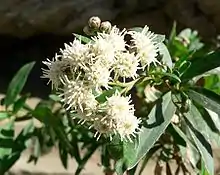Baccharis salicifolia
Baccharis salicifolia is a blooming shrub native to the sage scrub community and desert southwest of the United States and northern Mexico, as well as parts of South America. Its usual common name is mule fat;[1]:126 it is also called seepwillow or water-wally. This is a large bush with sticky foliage which bears plentiful small, fuzzy, pink or red-tinged white flowers which are highly attractive to butterflies.[2] The long pointed leaves may be toothed and contain three lengthwise veins. It is most common near water sources.
| Baccharis salicifolia | |
|---|---|
 | |
| Scientific classification | |
| Kingdom: | Plantae |
| Clade: | Tracheophytes |
| Clade: | Angiosperms |
| Clade: | Eudicots |
| Clade: | Asterids |
| Order: | Asterales |
| Family: | Asteraceae |
| Genus: | Baccharis |
| Species: | B. salicifolia |
| Binomial name | |
| Baccharis salicifolia | |
| Synonyms | |
| |
Uses
- The Kayenta Navajo people use this plant in a compound infusion of plants used as a lotion for chills from immersion.[3]
Another use is fire starting. Dried Baccharis salicifolia has a very low ignition temperature, very similar to the dried yucca stalk. It can be used for spindles and hand-drill shafts.
References
- Mojave Desert Wildflowers, Pam MacKay, 2nd ed., 2013, ISBN 978-0-7627-8033-4
- Soule, J.A. 2012. Butterfly Gardening in Southern Arizona. Tierra del Soule Press, Tucson, AZ
- Wyman, Leland C. and Stuart K. Harris 1951 The Ethnobotany of the Kayenta Navaho. Albuquerque. The University of New Mexico Press (p. 45)
External links
- Jepson Manual Treatment
- Photo gallery
 Media related to Baccharis salicifolia at Wikimedia Commons
Media related to Baccharis salicifolia at Wikimedia Commons
This article is issued from Wikipedia. The text is licensed under Creative Commons - Attribution - Sharealike. Additional terms may apply for the media files.